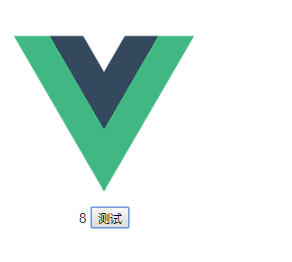一、Vuex简介
Vuex 是一个专为 Vue.js 应用程序开发的状态管理模式。它采用集中式存储管理应用的所有组件的状态,并以相应的规则保证状态以一种可预测的方式发生变化。
快速理解:每个组件都有它自己数据属性,封装在data()中,每个组件之间data是完全隔离的,是私有的。如果我们需要各个组件都能访问到数据数据,或是需要各个组件之间能互相交换数据,这就需要一个单独存储的区域存放公共属性。这就是状态管理所要解决的问题。
二、快速入门
1.工程搭建
用cmd新建一个基于 webpack 模板的新项目
# 创建一个基于 webpack 模板的新项目
vue init webpack vuexdemo
# 安装依赖
cd vuexdemo
npm install
cnpm install --save vuex
#运行
npm run dev
2.读取状态值
每一个 Vuex 应用的核心就是 store(仓库)。“store”基本上就是一个容器,它包含着你的应用中大部分的状态 (state)。
实现步骤:
用CS打开vuexdemo
(1)在src下创建store,store下创建index.js
import Vue from 'vue'
import Vuex from 'vuex'
Vue.use(Vuex)
const store = new Vuex.Store({
state: {
count: 0
}
})
export default store
(2)修改main.js,引入和装载store
import Vue from 'vue'
import App from './App'
import router from './router'
import store from './store'
Vue.config.productionTip = false
new Vue({
el: '#app',
router,
store,
components: { App },
template: '<App/>'
})
(3)修改components\HelloWorld.vue
<template>
<div>
{{$store.state.count}}
<button @click="showCount">测试</button>
</div>
</template>
<script>
export default {
methods:{
showCount(){
console.log(this.$store.state.count)
}
}
}
</script>
运行可以看到如下结果

3.改变状态值
你不能直接改变 store 中的状态。改变 store 中的状态的唯一途径就是显式地提交(commit) mutation。这样使得我们可以方便地跟踪每一个状态的变化,从而让我们能够实现一些工具帮助我们更好地了解我们的应用。
(1)修改store/index.js ,增加mutation定义
import Vue from 'vue'
import Vuex from 'vuex'
Vue.use(Vuex)
const store=new Vuex.Store({
state: {
count: 0
},
mutations: {
increment(state) {
state.count++
}
}
})
export default store
(2)修改components\HelloWorld.vue ,调用mutation
<template>
<div>
{{$store.state.count}}
<button @click="addCount">测试</button>
</div>
</template>
<script>
export default {
methods:{
addCount(){
this.$store.commit('increment')
console.log(this.$store.state.count)
}
}
}
</script>
测试: 运行工程,点击测试按钮,我们会看到控制台和页面输出递增的数字


4.状态值共享测试
如果是另外一个页面,能否读取到刚才我在HelloWorld中操作的状态值呢?我们接下来就做一个测试
(1)在components下创建show.vue
<template>
<div>
show: {{$store.state.count}}
</div>
</template>
(2)修改路由设置 router/index.js
import Vue from 'vue'
import Router from 'vue-router'
import HelloWorld from '@/components/HelloWorld'
import Show from '@/components/Show'
Vue.use(Router)
export default new Router({
routes: [
{
path: '/',
name: 'HelloWorld',
component: HelloWorld
},
{
path: '/show',
name: 'Show',
component: Show
}
]
})
测试: 在HelloWorld页面点击按钮使状态值增长,然后再进入show页面查看状态值
5. 提交载荷
所谓载荷(payload)就是 向 store.commit 传入额外的参数。
(1)修改store下的index.js
...
mutations: {
increment(state,x) {
state.count += x
}
}
...
(2)修改HelloWorld.vue
......
addCount(){
this.$store.commit('increment',10)
console.log(this.$store.state.count)
}
......
6.Action
- Action 类似于 mutation,不同在于:
- Action 提交的是 mutation,而不是直接变更状态。
- Action 可以包含任意异步操作。
我们现在使用 Action 来封装increment
(1)修改store/index.js,添加一个actions
actions: {
increment (context){
context.commit('increment',10)
}
}
(2)修改HelloWorld.vue
<template>
<div>
show: {{$store.state.count}}
<button @click="addCount">测试</button>
</div>
</template>
<script>
export default {
methods:{
addCount(){
this.$store.dispatch('increment')
console.log(this.$store.state.count)
}
}
}
</script>
我们使用dispatch来调用action , Action也同样支持载荷
7.派生属性Getter
有时候我们需要从 store 中的 state 中派生出一些状态,例如我们在上例代码的基础上,我们增加一个叫 remark的属性,如果count属性值小于50则remark为加油,大于等于50小于100则remark为你真棒,大于100则remark的值为你是大神. 这时我们就需要用到getter为我们解决。
(1)修改store/index.js ,增加getters定义
getters: {
remark(state){
if(state.count<50){
return '加油'
}else if( state.count<100){
return '你真棒'
}else{
return '你是大神'
}
}
}
Getter 接受 state 作为其第一个参数,也可以接受其他 getter 作为第二个参数
(2)修改HelloWorld.vue 显示派生属性的值
{{$store.getters.remark}}

三、模块化
1.Module
由于使用单一状态树,应用的所有状态会集中到一个比较大的对象。当应用变得非常复杂时,store 对象就有可能变得相当臃肿。
为了解决以上问题,Vuex 允许我们将 store 分割成模块(module)。每个模块拥有自己的 state、mutation、action、getter、甚至是嵌套子模块——从上至下进行同样方式的分割 .参见以下代码模型

我们现在就对工程按模块化进行改造
(1)修改store/index.js
import Vue from 'vue'
import Vuex from 'vuex'
Vue.use(Vuex)
const moduleA ={
state: {
count: 0
},
mutations: {
increment(state,x) {
state.count += x
}
},
actions: {
increment (context){
context.commit('increment',10)
}
},
getters: {
remark(state){
if(state.count<50){
return '加油'
}else if( state.count<100){
return '你真棒'
}else{
return '你是大神'
}
}
}
}
const store = new Vuex.Store({
modules: {
a:moduleA
}
})
export default store
(2)修改HelloWorld.vue和show.vue
{{$store.state.a.count}}
2.标准工程结构
如果所有的状态都写在一个js中,这个js必定会很臃肿,所以Vuex建议你按以下代码结构来构建工程

我们现在就按照上面的结构,重新整理以下我们的代码:
(1)store下创建modules文件夹,文件夹下创建a.js
export default {
state: {
count: 0
},
mutations: {
increment(state,x) {
state.count += x
}
},
actions: {
increment (context){
context.commit('increment',10)
}
},
}
(2)store下创建getters.js
export default {
remark: state => {
if(state.a.count<50){
return '加油'
}else if( state.a.count<100){
return '你真棒'
}else{
return '你是大神'
}
},
count: state=> state.a.count
}
(3)修改store/index.js
import Vue from 'vue'
import Vuex from 'vuex'
import a from './modules/a'
import getters from './getters'
Vue.use(Vuex)
const store = new Vuex.Store({
getters,
modules: {
a
}
})
export default store
(4)修改HelloWorld.vue
<template>
<div>
show: {{$store.getters.count}} {{$store.getters.remark}}
<button @click="addCount">测试</button>
</div>
</template>
<script>
export default {
methods:{
addCount(){
this.$store.dispatch('increment')
console.log(this.$store.getters.count)
}
}
}
</script>